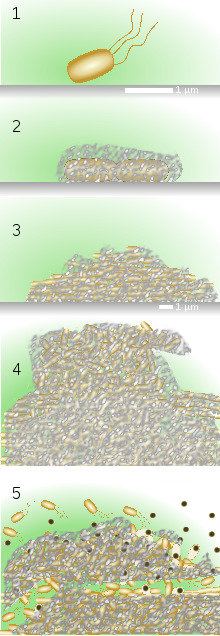
Colonisation or colonization (λ) is the process in biology by which a species spreads to new areas. Colonisation often refers to successful immigration where a population becomes integrated into a community, having resisted initial local extinction.
One classic model in biogeography posits that species must continue to colonize new areas through its life cycle (called a taxon cycle) in order to achieve longevity.[1] Accordingly, colonisation and extinction are key components of island biogeography, a theory that has many applications in ecology, such as metapopulations.
Scales
Colonisation occurs on several scales:
- biofilm scales: the formation of communities of microorganisms on surfaces.[2]
- small scales: colonising new sites, perhaps as a result of environmental change.
- large scales: where a species expands its range to encompass new areas. This can be via a series of small encroachments or by long-distance dispersal. The term range expansion is often used.[3]
Means
The term is generally only used to refer to the spread into new areas by natural means, as opposed to introduction or translocation by humans, which are called introduced species and sometimes becoming invasive species.
Species colonisation events
Large-scale notable pre-historic colonisation events include:
Humans
- the colonisation of areas outside of Africa by first peoples, eventually resulting in the extinction of most Pleistocene megafauna.
Some large-scale notable colonisation events in the 20th Century are:
Birds
- the colonisation of the New World by the cattle egret and the little egret.
- the colonisation of Britain by the little egret
- the colonisation of western North America by the barred owl,[4][5]
- the colonisation of the East Coast of North America by the Brewer's blackbird
- the colonisation-westwards spread across Europe of the collared dove
- the spread across the eastern USA of the house finch
- the expansion into the southern and western areas of South Africa by the Hadeda Ibis
Dragonflies
- Dragonfly - the colonisation of Britain by the small red-eyed damselfly
Moths
- Moth - the colonisation of Britain by Blair's shoulder-knot
See also
References
- ^ Wilson, E.O. (1962) The nature of the Taxon Cycle in Melanesian ant fauna "Archived copy" (PDF). Archived from the original (PDF) on 2011-07-20. Retrieved 2010-09-25. The American Naturalist
- ^ 1. O’Toole, G., Kaplan, H. B. & Kolter, R. Biofilm Formation as Microbial Development. Annu. Rev. Microbiol. 54, 49–79 (2000).
- ^ Yackulic, Charles B.; Nichols, James D.; Reid, Janice; Der, Ricky. 2015. To predict the niche, model colonization and extinction. Ecology. 96(1): 16-23.
- ^ Livezey KB. 2009a. Range expansion of Barred Owls, part I: chronology and distribution. American Midland Naturalist 161:49–56.
- ^ Livezey KB. 2009b. Range expansion of Barred Owls, part 2: facilitating ecological changes. American Midland Naturalist 161:323–349.